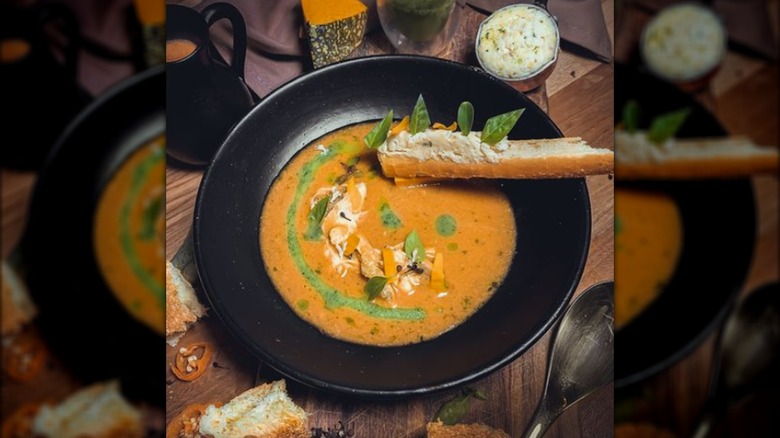The French Soup That Transported Anthony Bourdain Back To His Childhood
It was during a childhood trip to France that legendary chef and writer Anthony Bourdain first discovered that food was more than a thing people ate when they got hungry. A single raw oyster fished straight out of the ocean changed his life forever, but this pivotal moment was far from the only memorable impression that France left on Bourdain.
In one episode of "Parts Unknown," Bourdain lauded the rich, spicy Vietnamese soup bún bò Huế as "the greatest soup in the world." But, when it came to sentimentality, a different soup reigned supreme in Bourdain's heart over his stomach: French soupe de poisson. As he once told Food & Wine, "This more than anything is the flavor of my childhood vacations in France."
As much as New York City, the chef's career and preferences were colored by his connection to France. Bourdain was born of French descent, spoke the language growing up, spent multiple summers in France, and eventually became the executive chef of NYC's Brasserie Les Halles, an esteemed French fine dining bistro. He was an outspoken fan of traditional French classics like tartiflette and poulet basquaise, and he raved about Le Dôme, a seafood restaurant in Montparnasse. In his first show, "A Cook's Tour," Bourdain and his brother Chris traversed their ancestral homeland of Arcachon, France, trying the foods that they had cut their teeth on in an episode called "Childhood Flavors." It only makes sense that a French seafood stew would top his list.
Getting it on with soupe de poisson
If you've never tried it before, soupe de poisson is a Provençal seafood soup from the South of France. Each steaming bowlful is garnished with garlicky rouille-smeared toasts and a sprinkle of parmesan. The soup itself is made from a complex combination of saffron, orange, fennel, and Pernod, an anise liqueur with a strong licorice flavor. In this murky, intensely flavored broth floats the star of the show: fish heads. Not to be confused with bouillabaisse, another French seafood stew, soupe de poisson is made with small, whole, gutted fish with heads intact — Bourdain recommended porgy and whiting. Alternatively, an assortment of fish bones and heads works too.
In true Bourdain fashion, making this dish is a terrific exercise in branching out from the foods you might be familiar or comfortable with. What we mean is, when it comes to soupe de poisson, it's all about the fish heads. Fish heads are loaded with collagen, making for a richer, more viscous broth. In a fitting tribute to the champion of eating local, this recipe is also a great excuse to visit your neighborhood fishmonger. If fish heads just aren't your style, use a fish with a decent amount of natural gelatin in it to ensure the soup retains its signature richness. Rockfish from the Pacific Northwest is a good stand-in. In fact, per the lore, soupe de poisson might have started as a thrifty way to enjoy less desirable, less expensive fish.
A lifelong love affair with working-class French food
In the "Childhood Flavors" episode of "A Cook's Tour," Bourdain explained that, to him, French cuisine wasn't so much about glossy Parisian baguettes as it was pungent seafood caught by small-time fishermen. As he waxed nostalgic, "I have powerful memories of the taste of murky brown fish soup at the local joint, the taste of saucisson à l'ail, the smell of Gitanes cigarettes. Those summers played an important part of who I am today."
Indeed, these sensory, fish-heavy memories would shape much of Bourdain's career in the culinary world. In addition to serving as the executive chef of Les Halles, he also wrote the definitive "Les Halles Cookbook," which is loaded with classic French bistro recipes made the traditional way, no cutting corners.
In a later interview at Les Halles, when asked why he fell in love with French cuisine so much, Bourdain answered, "[Because] I grew up with it, my father was of French stock. Because it was the basis, the fundamental cuisine for all high-end cooking at the time ... And for better or worse, it was the food I had the best feeling for ... particularly this kind of cooking. You know, rustic. These are recipes that were developed by farmers, grandmothers, and hungry people." Fittingly, one of the defining characteristics of good French soupe de poisson is that it shouldn't look pretty. The beauty of this classic comes from its flavorful ingredients and masterful assembly, not from an aesthetic presentation.


